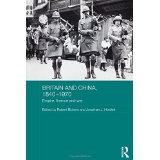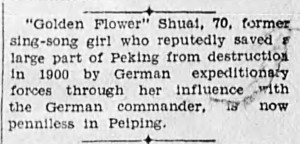Posted: July 31st, 2015 | No Comments »
Penguin paperbacks are 80 years old this week. They were revolutionary – though Allen Lane himself admitted there were antecedents (see my post on Albatross Books and Ella Maillart here).

The anniversary reminded me that as a kid I used to read my parents old Ernest Bramah Penguins on rainy days. Braham wrote the Kai Lung series, the fictional meanderings of a Chinese itinerant storyteller. I thought these fantastic at the time though today they are tricky to reread and a bit superfluous. They were pure chinoiserie – Bramah never ventured beyond Europe and certainly never to China. That’s OK – many others didn’t too, though Bramah’s Kai Lung stories never quite achieve either the surface charm or the underlying hard edge of Thomas Burke’s Limehouse Chinatown stories that were published slightly later. Bramah, after being rejected by many publishers, finally got Kai Lung into print in 1900. Still, to a young me, there were many wondrous sentences in Kai Lung – “He who lacks a single tael sees many bargains”; “It is a mark of insincerity of purpose to spend one’s time in looking for the sacred Emperor in low-class teashops”. Kai Lung and Bramah, courtesy of Penguin paperback reissues in the 1930s, were staples of chinoiserie reading though today have been almost totally forgotten…



Posted: July 30th, 2015 | No Comments »
Ronald Taylor’s biography of Arthur May, the man who famously hoisted the Union Jack back up in Hong Kong in 1945 after the Japanese surrender, is long overdue and well worth a read….

Arthur May is best remembered for his daring feat of hoisting the Union Jack on Hong Kong’s Peak on 18th August 1945, three days after the Japanese surrender. A few days later he sailed to Macao in a sampan to seek approval from the British Government for Franklin Gimson, the senior British subject then in Hong Kong, to take over the administration of Hong Kong from the occupying Japanese forces. How had Arthur remained out of internment for the majority of the Japanese occupation of Hong Kong and what did he do during this time? Was the hoisting of the flag instrumental in reclaiming Hong Kong for the British? Was his trip to Macao necessary? While out of internment Arthur befriended some of the Indian soldiers, who had been coerced to become guards for the occupying Japanese forces in return for better conditions for themselves. This liaison continued and expanded into a spy network after Arthur’s internment. It later assisted in preventing looting and disorder as British authority was re-established following the Japanese surrender. Arthur died in early 2000 at the age of 92. During his latter years he talked and made notes on what he had done during the Japanese occupation. This is Arthur’s story based on contemporary records, his memory and his notes.
Posted: July 29th, 2015 | No Comments »
In 1921 Macy’s department store in New York ran a promotion on books dealing with “The Difficult Asiatic Question”. Now, while obviously we all still remember Carl Crow (who happens to be the bargain purchase on the list at just a buck 74) the other authors are a little less well remembered. Probably second most remembered is BL Putnam Weale (real name Bertram Lenox Simpson), a Brit who’s father had been in the Imperial Maritime Customs. Putnam Weale was extremely well known in the China Hand business in the early twentieth century and The Truth About China and Japan is still worth a glance.
for the record – Hyndman was a British socialist, well known before the First World War; Pooley was a writer on various Japanese-based English language newspapers; Clarke was an Irish-American journalist and fervent Irish nationalist (as was, coincidentally, Hyndman – at least as a Home Ruler) who had been inspired to write about Japan by his friendship with the Japanese chemist Jokiche Takamine (himself a graduate student of Glasgow University, like all the best people); Sherrill was an American diplomat and US member of the International Olympic Committee between the wars who was rather aggrieved at never being selected as US Ambassador to Tokyo.

Posted: July 29th, 2015 | No Comments »
Here, from the Times of London, in 1889, a description of how beggars operated in Shanghai…

Posted: July 28th, 2015 | No Comments »
A new edited collection from Robert Bickers with plenty to interest all Chinarhymers I feel…..

This book presents a range of new research on British-Chinese relations in the period from Britain’s first imperial intervention in China up to the 1960s. Topics covered include economic issues such as fi nance, investment and Chinese labour in British territories, questions of perceptions on both sides, such as British worries about, and exaggeration of, the ‘China threat’, including to India, and British aggression towards, and eventual withdrawal from, China.
Introduction 1. ‘The Usual Intercourse of Nations’: The British in Pre-Opium War Canton John M. Carroll 2. British Intervention in the Taiping Rebellion Stephen R. Platt 3. Britain and China, and India, 1830s-1947 Robert Bickers 4. The Interest of Our Colonies Seems to Have Been Largely Overlooked: Colonial Australia and Anglo-Chinese Relations Benjamin Mountford 5. ‘Coolies’ or ‘Huagong’? Conflicting British and Chinese attitudes towards Chinese contract workers in World War One France Paul J. Bailey 6. Sino-British Relations in Railway Construction: State, Imperialism and Local Elites, 1905-1911 Koji Hirata 7. Foreign investment in modern China: an analysis with a focus on British interests Chen Qianping 8. Curative Finance: Francis Aglen, Bond Markets, and the Early Republic, 1911-1928 Hans van de Ven 9. Expansion and Defence in the International Settlement at Shanghai Isabella Jackson 10. Nationalistic Enthusiasm versus Imperialist Sophistication: Britain from Chiang Kai-shek’s Perspective Sherman Lai 11. ‘Decolonisation’ in China, 1949-1959 Jonathan J. Howlett
Posted: July 28th, 2015 | No Comments »
According to this article, from 1936, a former sing-song girl of Peking known as “Golden Flower” Shuai who had thwarted the German soldiers in the city in the aftermath of the Boxer Rebellion was reported to be living penniless in the city. I know nothing of the story of Shuai – if anyone does please do elucidate me….??

Posted: July 27th, 2015 | No Comments »
Toby Lincoln’s Urbanizing China in War and Peace looks interesting…

Urbanizing China in War and Peace rewrites the history of rural-urban relations in the first half of the twentieth century by arguing that urbanization is a total societal transformation and as important a factor as revolution, nationalism, or modernity in the history of modern China. Linking the global and the local in space and time, China’s urbanization was not only driven by industrial capitalism and the expansion of the state, but also shaped how these forces influenced daily life in the city and the countryside. Although the conflict that beset China after the Japanese invasion in 1937 affected the development of cities, towns, and villages, it did not derail previous changes. To truly understand how China has emerged as the world’s largest urban society, we must consider such continuities across the first half of the twentieth century – during periods of war as well as peace. The book focuses on Wuxi, a city that lies a hundred miles to the west of Shanghai. In the early twentieth century local industrialists were responsible for it quickly becoming the largest industrial city in China outside treaty ports. They built factories, roads, and other infrastructure outside the old city walls and in surrounding towns and villages. Chapters examine the countyAEs transformation as recorded in guidebooks and travel magazines of the time and the role of the state in the early 1920s and into the Nanjing Decade, when new administrative laws led to the continued expansion of the city under both municipal and county officials. They explore the revival of the silk industry during the Japanese occupation and the industry’s role in driving urbanization, as well as efforts by Chinese leaders to carry out prewar development plans despite lockdowns and qingxiang (clean the countryside) campaigns. In the midst of the barbed wire and watch towers, plans to shape the built environment in Wuxi County and the region as a whole persisted and were carried out. Ambitious and well researched, Urbanizing China in War and Peace will appeal to scholars and students of Chinese urban history, the Anti-Japanese War of Resistance, and the Republican period. Its engagement with issues of urbanization in general will interest urban historians of other times and places.
Posted: July 26th, 2015 | No Comments »
Alarming to read in the Taipei Times of the possible destruction and demolition of the old Kaohsiung Harbor Train Station, otherwise known as the Takao Post. It’s been kept for some time at the Takao Railway Museum but now the light rail authorities want to turn the site into a park or something. The building, constructed around 1900 as the first railway station in Kaohsiung was classified as a historic monument in 2003 and has been a museum since about 2010 after ceasing to be a functioning station in 2008. However, it is a classic Japanese colonial period structure with a Chinese hip style roof. There is a campaign to preserve and save the building that will hopefully be successful…

The Takao Post when in use as a station

the site as a museum today











